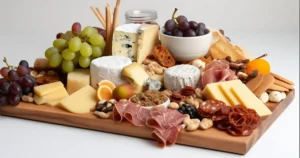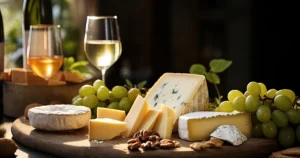World War I Inspiration
The French 75 cocktail is said to have been created in Paris during World War I. It was named after the French 75mm field gun, which was known for its quick-firing and powerful artillery. The cocktail’s name and its association with firepower are thought to have been inspired by the drink’s potent and sparkling nature.
Origin of the Recipe
The exact origin of the French 75 is a subject of debate among cocktail historians. Some credit Harry MacElhone, an American bartender working at the New York Bar (now known as Harry’s New York Bar) in Paris, with inventing the cocktail in 1915. Others attribute its creation to other bartenders in Paris during the same period.
Classic Ingredients
The classic French 75 recipe typically includes gin, fresh lemon juice, simple syrup, and champagne. It’s known for its effervescence and refreshing citrus notes, making it a delightful and celebratory cocktail.
Evolution and Variations
Over time, the French 75 has undergone variations and adaptations. Some variations may use cognac or brandy instead of gin, and different types of sparkling wine or champagne may be substituted. Additionally, some recipes may call for the addition of orange liqueur or other flavoring agents.
Popularity Resurgence
The French 75 experienced a resurgence in popularity during the cocktail renaissance of the late 20th and early 21st centuries. Craft cocktail bars and mixologists reintroduced classic cocktails like the French 75 to a new generation of cocktail enthusiasts.
Today, the French 75 remains a beloved classic cocktail known for its elegance, effervescence, and timeless appeal. It’s often enjoyed as a celebratory drink for special occasions or as a refreshing choice for those who appreciate a balanced combination of spirits and champagne.
Popularity During Prohibition
The French 75 cocktail became popular during the Prohibition era for several reasons:
Masking Low-Quality Spirits
During Prohibition (1920-1933), the production, sale, and distribution of alcoholic beverages were banned in the United States. As a result, many people turned to illegal and often poorly made spirits that had an unpleasant taste. Cocktails like the French 75, with its combination of gin (or other spirits), lemon juice, and champagne, helped mask the undesirable flavors of bootlegged alcohol, making it more palatable.
Sophistication and Elegance
The French 75 is a sparkling and visually appealing cocktail served in a champagne flute or coupe glass. Its presentation and effervescence gave it an air of sophistication and elegance, making it a popular choice for those seeking a refined drinking experience during a time when speakeasies and underground bars flourished.
Celebration and Camouflage
Despite Prohibition, people still wanted to celebrate special occasions and socialize. The French 75, with its festive bubbles and balanced flavor profile, made it an excellent choice for clandestine gatherings and celebrations. Its appearance in a champagne glass also helped disguise it as a non-alcoholic beverage, allowing patrons to enjoy it discreetly in speakeasies.
Variations and Adaptations
The French 75’s versatility allowed bartenders to experiment and create variations that suited their patrons’ preferences. Some variations used different base spirits like cognac or brandy, providing a range of options to cater to various tastes.
International Influence
The French 75’s origins in Paris and its association with French culture may have added to its allure during Prohibition. Paris was seen as a hub of sophistication and cultural exchange, and cocktails with French names and ingredients held a certain appeal.
Overall, the French 75’s popularity during Prohibition can be attributed to its ability to make subpar spirits more enjoyable, its elegance and celebratory nature, its adaptability, and its connection to international culture and trends. It remains a classic cocktail appreciated for its history and taste to this day.
Classic French 75 Recipe
Ingredients:
1 1/2 ounces gin
3/4 ounce fresh lemon juice
1/2 ounce simple syrup (or adjust to taste for desired sweetness)
2 ounces champagne or sparkling wine (chilled)
Lemon twist or cherry for garnish (optional)
Instructions:
In a cocktail shaker, add the gin, fresh lemon juice, and simple syrup.
Fill the shaker with ice.
Shake the mixture vigorously for about 10-15 seconds to chill and mix the ingredients thoroughly.
Strain the cocktail into a chilled champagne flute or coupe glass.
Top off the glass with 2 ounces of chilled champagne or sparkling wine.
Gently stir to combine.
Optionally, garnish the cocktail with a lemon twist or a cherry for an added touch of elegance.
Serve and enjoy!
3 Popular Variations
French 76
Ingredients:
1 1/2 ounces vodka
3/4 ounce fresh lemon juice
1/2 ounce simple syrup
2 ounces champagne or sparkling wine (chilled)
Instructions:
In a cocktail shaker, combine vodka, fresh lemon juice, and simple syrup.
Shake with ice to chill and mix.
Strain into a chilled champagne flute or coupe glass.
Top with chilled champagne or sparkling wine.
Garnish with a lemon twist or cherry, if desired.
The French 76 is essentially a French 75 with vodka as the base spirit, making it a bit lighter in flavor and a popular choice for those who prefer vodka over gin.
French 95
Ingredients:
1 1/2 ounces bourbon
3/4 ounce fresh lemon juice
1/2 ounce simple syrup
2 ounces champagne or sparkling wine (chilled)
Instructions:
In a cocktail shaker, combine bourbon, fresh lemon juice, and simple syrup.
Shake with ice to chill and mix.
Strain into a chilled champagne flute or coupe glass.
Top with chilled champagne or sparkling wine.
Garnish with a lemon twist or cherry, if desired.
The French 95 is a variation that substitutes bourbon for the gin, resulting in a richer and slightly sweeter cocktail compared to the classic French 75.
French 125
Ingredients:
1 1/2 ounces cognac
3/4 ounce fresh lemon juice
1/2 ounce simple syrup
2 ounces champagne or sparkling wine (chilled)
Instructions:
In a cocktail shaker, combine cognac, fresh lemon juice, and simple syrup.
Shake with ice to chill and mix.
Strain into a chilled champagne flute or coupe glass.
Top with chilled champagne or sparkling wine.
Garnish with a lemon twist or cherry, if desired.
The French 125 uses cognac as the base spirit, creating a smoother and more refined version of the French 75, perfect for those who enjoy the complexity of cognac in their cocktails.
These variations offer different flavor profiles while maintaining the effervescent and celebratory nature of the classic French 75. You can choose the one that aligns with your preferred base spirit and taste preferences.
Our bartenders would love to serve this at your next party so please reach out and make a reservation!




